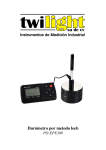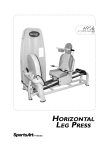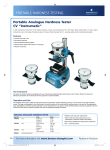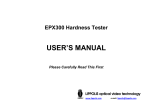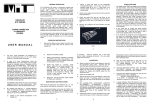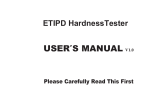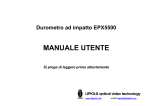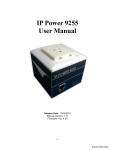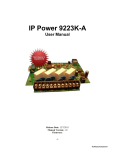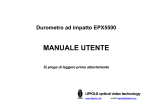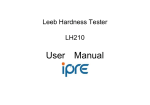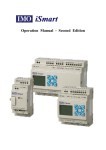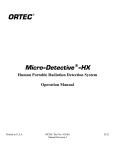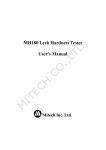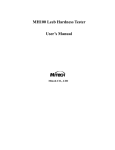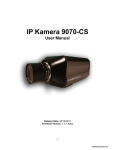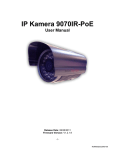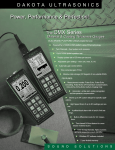Download EPX300 user manual
Transcript
EPX300 Hardness Tester USER’S MANUAL Please Carefully Read This First LIPPOLIS optical video technology www.lippolis.com e-mail: [email protected] Contents Caution………………………………………………………………………1 1. SUMMARIZE……………………………………………………………..2 1.1 Measuring Principle Scope…………………………………………..2 1.2 The Hardness Value “L”...……………………………………………5 1.3 Main Features…………………………………………………………6 1.4 Application Range…………………………………………………….7 1.5 Technical Information…………………………………………………..8 1.5.1 Display Unit……………………………………………………………8 1.5.2 Impact Device D…………………………………………………….9 1.5.3 Impact Device DC…………………………………………………10 1.6 Overview the Display Unit……………………………………………11 1.7 Impact Device D Type……………………………………………….12 2. CHECKING SUPPLIED ACCESSORIES…………………………..13 3. QUICK START GUIDE……………………………………………….15 3.1 Connect………………………………………………………………...15 3.2 Calibration……………………………………………………………...16 4. OPERATING INSTRUCTIONS………………………………………..17 4.1 Display Unit…………………………………………………………….17 4.1.1 Keys…………………………………………………………………..17 4.1.2 Measurement Mode…………………………………………………21 4.1.3 Setup…………………………………………………………………22 4.1.3.1 Material Group…………………………………………………….22 4.1.3.2 Impact Direction…………………………………………………...23 4.1.3.3 Scale……………………………………………………………….24 4.1.3.4 Browse……………………………………………………………..25 I II 4.1.3.5 Adjust the Clock and Calendar………………………………...26 4.1.3.6 Calibration…………………………………………………...........29 4.2 The Format of Memory Data………………………………………..34 4.3 Backlight………………………………………………….…………..35 4.4 System Reset…………………………………………………………35 4.5 Automatic Shutdown…………………………………………………36 5ˊ ˊDATA PRINT……………………………………………………………37 5.1 Printer Link…………………………………………………………….37 5.2 Test Report Format……………………………………………………39 6ˊHARDNESS TEST……………………………………………………40 6.1 Test Preparation……………………………………………………...40 6.2 Sample Preparation………………………………………………….40 6.3 Test Steps…………………………………………………………….44 7ˊ ˊTROUBLES AND SOLUTIONS………………………………………48 8ˊMAINTENANCE AND SERVICE…………………………………….49 8.1 Impact Device Maintenance………………………………………...49 8.2 Store the Report…………………………...…………………………49 8.3 Normal Maintenance Procedures…………………………………..50 Appendix 1 DAILY CHECKING………………………………………..51 Appendix 2 FACTORS AFFECTION THE ACCURACY……………52 Appendix 3 MEASUREING AND CONVERSION RANGE…………55 Appendix 4 MATERIAL CODE…………………………………………56 III IV 1. SUMMARIZE CAUTION 1.1 Measuring Principle Scope Please Carefully Read This First EPX300 Hardness Tester measuring principle is physically a rather simple, dynamic hardness tester. An impact body with a hard metal test tip is propelled by spring force against the surface of the test piece. Surface deformation takes place when the impact body hits the test surface, which will result in loss of kinetic energy. This energy loss is calculated by velocity measurements when the impact body is at a precise distance from the surface for both the impact 1. Users can only use the special battery offered by our company in display unit, or else may cause damage to products, battery leakage, even fire or explosion. 2. Any components of the product can’t be submerged in water and exposed in the rain, which could cause a battery explosion, and display unit damage. 3. Avoid electrical shock, do not open the cabinet. 4. Store the instrument in a dry and cool place if it is not used for a long time. 1 and rebound phase of the test. The permanent magnet in the impact body generates an induction voltage in the single coil of the impact device. The voltage of the signal is proportional to the velocity of the impact body, and signal processing by the electronics provides the hardness reading for display and storage. Simply put, harder materials produce higher rebound velocity than those which are less hard (higher L value). EPX300 Hardness Tester is a direct hardness measurement within any particular material group (i.e. steel, aluminum, etc.) and can be used as a final test result 2 without conversion. However, EPX300 Hardness Tester has established conversions to other hardness scales for the convenience of our customers. These conversions to other scales (HRC, HRB, HB, HV, HSD etc.) are programmed into the electronics, and can be shown directly on the display as the test result. All data is stored in the native L scale to prevent any possible errors with multiple conversions. 3 4 1.2 The Hardness Value "L" This term, 1978 introduced by Doctor Dietmar Leeb into measuring technology, is the quotient for the impact body's rebound and impact velocity, multiplied by 1000. Harder materials produce higher rebound velocity than those which are less hard. With reference to a particular material group (e.g. steel, aluminum etc.)ˈthe L-value represents a direct hardness measurement and is used as such. Comparison curves with standard static hardness values have been established (Brinell, Vickers, Rockwell C, B,Shore D) for the most prevalent materials, enabling the L-value to be converted into the relevant values for these procedures. With EPX300 Hardness Tester, such hardness values can be directly displayed in the hardness scales HRC, HRB, HB, HV, HSD and tensile strength (MPa). 5 z z z z z High accuracy:f6 HL Automatic correction for impact direction Large, easy to read display with backlight User profiles for fast change of all settings Converts to all common hardness scales (HB, HRB, HRC, HV, HSD) and tensile strength MPa. z Powered by dry cell, Ultra-low-power z Easy calibration z Conforms to the Standard ASTM A956-02 & DIN50156 6 1.5 Technical Information 1.4 Application Range z z z z z z z z z z z z z z 1.3 Main Features Good for all metals Ideal for production level testing Best suited for on-site testing of heavy, big or already installed parts Handy for difficult to access or confined test locations Automatic compensation for impact direction Excellent for material selection and acceptance tests Easy to use and accurate on curved test surfaces (R > 10 mm) Metal production & processing Automotive & transportation Machinery & power plants Petro-chemical, refineries Aerospace & shipyard Metal constructions Testing services & laboratories 7 1.5.1 Display Unit z z z z z z z z z z 8 HL display range: 0̚999HLD Accuracy:f6 HL(at 800HLD) LCD: large LCD with backlight Resolution: 1 HL; 1 HV; 1 HB; 0.1 HRC; 0.1 HRB; 1 HSD; 1 MPa Power: dry cell (3 x1.5V AAA) Operating temperature: 32 ~ 122eF Storage temperature: 14 ~ 144eF Humidity: 5 % ~ 95% Dimensions: 150mm x 80mm x 24mm (5.9 x 3.1 x 0.9 inches) Weight: Approx.200g(display unit) 1.5.2 Impact Device D 1.5.3 Impact Device DC z Impactenergy: 11 Nmm z Mass of the impact body: 5.5g z Test tip diameter: 3mm z Test tip material: tungsten carbide z Test tip hardness: ı1600HV z Impact length: 147mm z Impact maximum diameter: 20mm z Impact weight: 75g z z z z z z z Impactenergy: 11 Nmm Mass of the impact body: 5.5g Test tip diameter: 3mm Test tip material: tungsten carbide Test tip hardness: ı1600HV Impact length: 86mm Impact maximum diameter: 20mm z Impact weight: 50g Notes: 1. The impact unit DC is used in a narrow space, such as in hole, in cylinder or inside of assembled machine. 2. The impact unit DC is very short, a special load pole is needed when loading, the others is the same as the impact unit D. 9 1.6 Overview the Display Unit 10 1.7 Impact Device D type᧤Fig.1.2᧥ LCD Display 1. Impact Body 2. Support Ring 3. Coil 4. Cable 5. Catch Chuck 6. Loading Tube 7. Release Button IR Port Serial Port Cell Cover Bracket Signal Cable Label (With material code) Fig.1.1 Display Unit Fig.1.2 11 12 2. CHECKING SUPPLIED ACCESSORIES Documents Display Unit Make sure you have each items, you can obtain various accessories from your local dealer. (Fig. 2.1) The items are supplied with your hardness tester and the accessories available at your dealer may vary, depending on your country or service provider. Use the purchased accessories with only authorized devices. The use of these accessories with other devices could cause problems and any repair costs would not be covered by the warranty. Test Block Impact Device D Charger Carrying Case Little Support Ring, Cleaning Brush, Printer Cable etc. 13 3. QUICK START GUIDE Mini-Printer Fig.2.1 14 3.2 Calibration Test block are calibrated in accordance with the dynamic hardness 3.1 Connect value L in order to making sure the hardness tester work well. You Connect the signal cable to the impact device. (Fig.3.1) must be calibrated it on the test block before using the hardness tester for the first time. (Appendix 1) Fig.3.1 15 16 4. OPERATING INSTRUCTIONS 1. “ ” On/Off button: turn it on by pressing and holding “ ” button, If the display unit is on, turn it off by pressing and holding 4.1 Display Unit 2 4.1.1 Keys (Fig.4.1) “ 2. “ 1 ” button. ” Backlight button: Press“ ” button to turn on the LCD backlight; Press again to turn off the LCD backlight. 3 9 3. “Back/Print” button: 㽲㪠㫅㩷㫄㪼㪸㫊㫌㫉㪼㫄 㪼㫅㫋mode, press and hold “Back/Print” button to 8 erase the measured data, at the same time, if the mini-printer is linked with the display unit, it will print out those data. 7 4 㽳㪠㫅㩷other mode, press “Back/Print” button to complete setup and 6 5 save the parameters that you set and return to the measurement Fig.4.1 17 18 mode. in measurement mode. In Date/Time setup mode and calibration 4. “MEMORY” button: Browse the memory data. mode, press “ 5. “Date/Time” button: adjust the clock and calendar. browse mode, press “ 6. “ ” button: press and hold “ ” button to delete current 9. “ ” button: press “ next bit. ” button to decrease the flickering bit. In browse mode, press “ 8. “ ” button: press “ ” button: in measurement mode, press “ mode and calibration mode, press “ ” button to setup the conversion scale in measurement mode. In Date/Time setup mode and calibration mode, press “ ” button to display the previous data. ” button to select the material that you will impact. In Date/Time setup data in measurement mode or browse mode. 7. “ ” button to increase the flickering bit. In ” button to display the next data. ” button to setup the impact direction 19 20 ” button to select the 4.1.2 Measurement mode 4.1.3 Setup EPX300 Hardness Tester has a large LCD and display abundance of information. (Fig. 4.2) 4.1.3.1 Material Group ” button to select the material you will impact. The material list is on the back label. Conversion Value Conversion Scale Conversion Averaged Value In measurement mode, press “ Press “ ” continuously, the material changes according to following sequence: 010203…1011…2001 Clock Material Code Note: HLD Averaged Value 1. It is necessary to select the material classification. When you did not know the material type, you must be reference the related material handbook. Impact Direction 2. Default setting: steel and cast steel HLD Value Impact times Fig.4.2 21 4.1.3.2 Impact Direction Ideal Leeb Hardness Testing is a downward straight testing method. As a result of gravity, the test should be amended when measuring other directions in order to measuring correct hardness value of material. As long as you correctly choose the impact direction, EPX300 Hardness Tester can automatically be amended. There are five impact directions to choose: In measurement mode, press “ ᇬ ᇬ ᇬ ᇬ 4.1.3.3 Scale EPX300 Hardness Tester can automatically convert HLD values to other hardness scales HRC, HRB, HB, HV, HSD or tensile strength (MPa) according to a particular material group (e.g. steel, aluminum etc.) In measurement mode, press “ ” button to select the impact ” to convert to all common hardness scales or tensile strength (MPa); Press “ direction, the impact direction changes according to following sequence: 22 ” continuously, the scale according to following sequence: HRC Note: Default Setting: Notes: 1. The conversion value is “---” indicated the conversion is out of range. 23 24 2. When you set the conversion from hardness scale to tensile strength or back to the measurement mode. from tensile strength to hardness scale, you must be reset the material group. 4.1.3.5 Adjust the clock and the calendar 3. Conversion value only supplies the general reference, which may result in EPX300 Hardness Tester has built-in real-time clock system. some offset. Precisely conversion generally needs related comparative tests. It must be adjusted when you reinstall the dry cell or other necessary 4. Default setting for the conversion is “HRC”. case. Steps of setting time as follows: 4.1.3.4 Browse Press “Date/Time” button enter to the clock and the calendar Press “Memory” button to browse stored data and display the first data adjustment mode, and the “month” will be flicker, press “ group in last nine test data, including hardness value HLD, material, to increase, and press “ conversion values, impact direction, date and time etc. Press “ ” button to decrease, (valid number is 1 to 12). ” button to browse the next data group, and press “ ” Then press “ ” button, the “day” will be flicker, press “ button to browse the previous data group. Press “Back/print” button 25 button to increase, and press “ 26 ” button to decrease, (valid number Month is 01 to 31). Then press “ ” button, the “year” will be flicker, press “ button to increase, and press “ ” Minute Day ” button to decrease, (valid number Year is 00 to 99). Then press “ ” button, the “hour” will be flicker, press “ Hour ” Fig.4.3 button to increase, and press “ ” button to decrease, (valid number is 00 to 23). Then press “ Press “Back/Print” button at any time, it means complete the ” button, the “minute” will be flicker, press “ button to increase, and press “ ” button ” adjustment and return to measurement mode. ” button to decrease, (valid number is 00 to 59). 27 28 ” 4.1.3.6 Calibration Press and hold “Date/Time” button about 2 seconds to display the Calibration is used to calibrate the measured value (HLD, HRC, HRB, calibration mode. (Fig.4.4) HB, HV, HSD) of the hardness tester, so as to farthest decrease the 2) If you want to calibrate the HRC, HRB, HB, HV, HSD, you have to measuring error, In your calibration (HRB, HB, HV, HSD), you should press and hold the “browse” button then press the “date / time” button, first be converted into the current scale, such as to calibrate the HB, At this time the scale what you want to calibrate will be display.(Fig.4.5) you should choose according to HB by “Convert” button. 3)If you just want to calibrate the HLD, You don’t do the up step. Please as follows: Enter the value that marked on test block through the “ 1) Press “Back/Print” button for about 2 seconds until the number of or “ impact times flicker that the impact time become to “0”, impact five finished. (Fig.4.6, Fig.4.7, Fig.4.8) ” button and then press “Back/Print” button, the Calibration times in test blocks to obtain the average value (can delete some error data in operation). 29 Fig.4.4 30 Fig.4.5 Fig.4.8 Fig.4.6 Fig.4.7 31 32 ” or “ ” Note: 4.2 The Format of Memory Data 1. If it’s the first time to use the hardness tester or has been so long since the The data group (such as test result, conversion result, sample material and impact direction) automatically save in memory after one individual measurement. EPX300 Hardness Tester can store nine sets of data, when measuring times more than nine, the last group of data will store the 9th position and the first group of data will be erased. The second group of data will be moved to the 1st position, simultaneously the position of other group of data, will be moved to lower position. Press and hold “Back/Print” button to end the measurement and print out the memory data (when connected to printer). The original data will be erased automatically when the print completed. last time, users should calibrate the m machine by standard hardness block. 2. The default impact direction is . (Appendix 1) 3. No matter the counter is 0 or not, you must press “Back/Print” button and hold it about 2 seconds to clear the counter before you calibrate the hardness tester. 4. In the HRC, HRB, HB, HV, HSD calibration mode, if you want to enter the hardness value with a decimal point, such as 25.6HRC, you should enter 256, such as the number to be entered 85HB, you should enter the number 085. if the input data exceeds the range, the machine will not perform calibration 33 34 4.3 Backlight 4.5 Automatic Shutdown Highlight LED backlight is used for poor light conditions. Users can turn on or turn off the backlight by pressing “ ” button (it will automatically save this model while shutdown). If there is no measure, and no key operation in 10 seconds, the backlight will be turning off automatically, and the display unit will be shut off in 3 minutes. If there is no measurement and no operation in 3 minutes, display unit will automatically switch off in order to save battery power. Display unit will automatically store all the parameters before turning-off. 4.4 System Reset If the display unit isn’t working properly or halt, users can press the “Reset” button by insert a slender rod into the reset hole at the backside of display unit, and then the display unit will be shutdown. Press and hold “ ” button to reboot the system. 35 36 5. DATA PRINT socket at the left side of printer, users can now boot the printer by pressing POWER button turn on the printer, and turn on the display unit next. The other printing way is infrared printing, put the display unit’s infrared launch window at the level of printer’s infrared receive window, see Fig 5.1. At this time, users can use infrared printing like serial printing. EPX300 Hardness Tester can be linked with micro printer, and then the printer can print out hardness test result report. 5.1 Printer Link Switching off the power of the display unit, users can then insert the USB plugs of printer cable (optional) into the USB jack for printer, and insert the other side of cable into the Fig.5.1 Note: 1. When using serial cable to print, users cannot put the hardness tester's infrared launch window at the level of printer's infrared receive window; similarly, when using infrared print, users should pull down the serial cable. Otherwise, the printer will print unrecognizable code; even the paper will be non-stop output from printer. 37 38 6. HARDNESS TEST 5.2 Test Report Format A complete test report format is shown at fig.5.2. 6.1 Test Preparation 1) Make sure the system connection is safe and reliable. 2) Press “ ” button to switch on the power, inspect if every setting of display unit is correct, particularly the materials type and impact direction. The setting inconsistent with the actual condition may set up a great error. Note: The date and time printed in the last line of the report is the time when printing, and the time below the test value is the time when testing. 6.2 Sample Preparation Inappropriate sample will cause a great measurement error. Therefore, users should make the necessary handling and preparation under the original conditions of sample. Preparation of the sample and the surface of test should be coincident with the following basic requirements: Fig.5.2 39 40 1) During the process of sample surface preparation, users should avoid the impacts of cold processing and thermal processing. 2) The sample surface is plane for better, the test surface should be with a metallic sheen, and not involve oxide layer or other stains. 3) Roughness of the test surface Raİ1.6 4) Sample must be of sufficient quality and rigidity. If it’s lack of quality and rigidity, it may cause displacement or shaking in the process of testing impact, which can lead to large errors. Generally speaking, if the sample quality is more than 5kg can be directly tested; if the sample quality is 2~5kgs, the sample should be taken in fixation test by means of appropriate clamping; if the sample quality is 0.05~2kgs, the sample should be conducted coupling before the test; if the sample quality is less than 0.05kg, 41 6) When testing sample surface is not horizontal, the curvature radius of testing and nearby surface should be larger than 30mm. And appropriate supporting ring should be elected and installed. 7) A sample should not be with magnetic. The signal of the impact device would be seriously interfered in the work by the magnetic, which may cause inaccurate test results. this hardness tester is inappropriate to use. Coupling method: Testing sample’s back should be prepared to make a plane as a supporting surface with a smooth formation. Filling with a little coupling substance (Industry Vaseline can be used), users can now press to the surface of the supporting object (The weight of supporting object should be more than 5 kg, and it can be replaced by test block) to stick into integration. 5) Samples should be thick enough and with sufficient surface absorption layered. If users use D-type impact device, the thickness of sample should not be less than 5mm, and surface absorption layer (or surface-hardening layer) should not be less than 0.8mm. To accurately measure the hardness of the material, the best way is to remove the surface-hardening layer by processing. 42 6.3 Test Steps 1) Loading Simply load the impact device by sliding the loading tube forward. Fig 6.1 Load 2) Place Then place and hold the impact device on the surface of the test piece at the desired test point. Impact indirection should be vertical with the test of surface. Fig 6.2 Place 43 44 3) Burst impact (Measure) Trigger the impact by pressing the release button. The hardness value will be instantaneously displayed. 4) Read off the test result Read off the test result from LCD at Fig 6.3 Burst Impact figure 6.4. Sample material: steel and cast iron; Impact direction: downwards; Date: 3rd, Dec; The current hardness value: 786HLD; The current measurement is the third point; Fig 6.4 45 46 7. TROUBLES AND SOLUTIONS The current mean value: 785HLD Conversions to HRC: 58.6HRC The mean value of HRC: 58.5HRC Repeating the above steps, users can carry out tests in more points. No. Note: Generally, each measurement location of sample is conducted for the five tests. The “S” (difference of maximum value and minimum value) values must be less than 15HL. The distance between any two impact position Reasons No response switched Lack power Replace battery 2 Keys no response System halt Reset 3 Abnormally high results Steel ball wearing Replace the Steel ball 4 No test results Sensor cables loose Re-linking 5 Printer no response Printer cable loose Re-linking ˆOther Trouble ,please contact with agents or distributor. 47 48 Solutions 1 should beı3 mm ; the distance between impact position and the edge of the sample should beı3 mm. Trouble 8. MAINTENANCE AND SERVICE kept in long-term preservation, please copy and preserve in time. 8.3 Normal Maintenance Procedures 8.1 Impact Device Maintenance After using 1000-2000 times, users should clean the catheter of impact device and impact body with nylon brush, and screw off the supporting ring before clean the catheter, and then take out the impact body, rotate the nylon brush into the tube in an anti-clockwise direction, and pull out when touching the bottom. So repeatedly, and then load up the impact body and supporting ring; Users should release the impact body after use. And the lubricant is banned. 8.2 Store the Report Because printing paper is thermal paper, it should be preserved to avoid the heat and direct light. If the print records are necessary to be 49 In calibration of the hardness tester, if finding that error is larger than 12HLD, users must be renew the steel ball or impact body, because the reason may be that the steel ball or impact body is wore out to lead to failure in operation. When the hardness tester arises other abnormal phenomena, users should not demolish or adjust any fixed assembly parts, instead, they should complete warranty cards, send them to maintenance department of agent or professional maintenance organizations authorized by agent for maintenance. Machine staying in maintenance organizations generally do not last more than a week. 50 Appendix 1 DAILY CHECKING Normal test block is mainly used for calibrate the hardness tester. The error and the repeatability of the hardness tester should be in the scope defined by the following table. Impact Device Impact direction D Hardness of Test block (HL) 750̚830 490̚570 Error Allowed f12HLD f12HLD Repeatability Allowed 12HLD 12HLD Note: 1. Error=HLD-HLD HLD is the average value of 5 values measured on the test block. HLD is the value that marked on test block. 2. Repeatability= HLDmaxˉHLDmin Appendix 2 FACTORS AFFECTION THE ACCURACY Incorrect operation or improper testing conditions would have serious impact on testing accuracy. Following is several common factors affect the accuracy of testing for the use of reference: 1) Roughness of sample surface When the impact body impact on the sample, a small pit would arise on the sample surface, so at the same time, should finish the surface of the sample. The more roughness, the less consumption of impact energy whereas the less roughness, the more consumption of impact energy. Accordingly, the roughness of sample testing points on the surface Raİ1.6. HLDmax is the maximum value in 5 values that measured on the test block. HLDmin is the minimum value in 5 value measured on the test block. 51 52 2) The shape of sample surface Leeb testing principle demands the velocity of rebound and impact are on the same line, because the impact body is moving in a metal tube. Even if the velocity of rebound and impact are not on the same line, it also can show hardness for sure, but the impact body would collide with tube wall when it rebounds, which will affect the velocity of rebound. Therefore, a greater error is on test accuracy. When the radius of curvature of the testing sample surface is smaller, the solution is the use of suitable variant supporting circle. If users require special supporting circle, we can contribute to design and process. 3) The weight of the sample If the sample weight must be larger than or equal to 5kg, and not easily sway. If the sample weight were less, the sample would need proper treatment (It is necessary to increase the supporting or mounting 53 through coupling compress on larger weight testing stand), and the testing results can be achieved in accuracy. There should be a certain area at the testing points (the area required to meet a set of testing points) and no vibration or shaking. If the weight is not enough, users must be as much as possible reduce the jitter and sloshing by the methods of increasing supporting, coupling and compressing. And supporting device should avoid shock. 4) The sample stability Any effective tests need to minimize possible interference from outside; it’s more important to dynamic measure such as Leeb hardness test. Therefore, measuring only allowed in stable hardness testing system. If it’s likely to lead to sample movement in the tests, users should fix it before testing. 54 Appendix 3 MEASUREING AND CONVERSION RANGE Materials HV HB Steel & Cast Steel 81-955 81-654 Alloy Tool Steel 80-898 Stainless Steel 85-802 Grey Cast Iron HRC 20.0-68.4 HRB 38.4-99.5 Tensile strength (MPa) 32.5-99.5 375-2639 19.6-62.4 46.5-101.7 Code 01 Steel & Cast Steel Tensile Strength Code Material 11 Low Carbon Steel 02 Alloy Tool Steel 12 Hi Carbon Steel 740-1725 03 Stainless Steel 13 Chrome Steel 04 Grey Cast Iron 14 Cr-V Steel 05 Ductile Iron 15 Cr-Ni Steel 140-387 06 Cast Aluminum Alloys 16 Cr-Mo Steel 07 Brass 17 Cr-Ni-Mo Steel 60-290 08 Bronze 18 Cr-Mn-Mo Steel 45-315 09 Copper 19 Cr-Mn-Si Steel 142-651 10 Forging Steel 20 Hi Strength Steel Cast Aluminum Alloys 19-164 23.8-84.6 Brass 40-173 13.5-95.3 Bronze Copper 83-976 Hardness Material 375-2639 63-336 Ductile Iron Forging Steel HSD 20.4-67.1 85-655 Appendix4. MATERIAL CODE 19.8-68.5 59.6-99.6 26.4-99.5 55 56

















